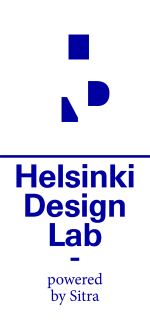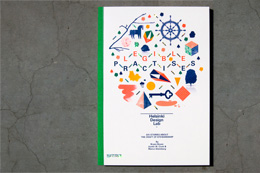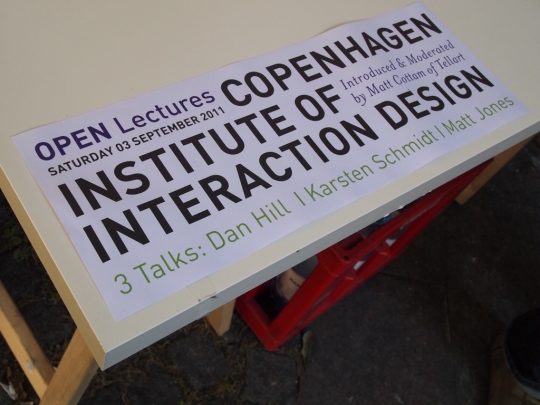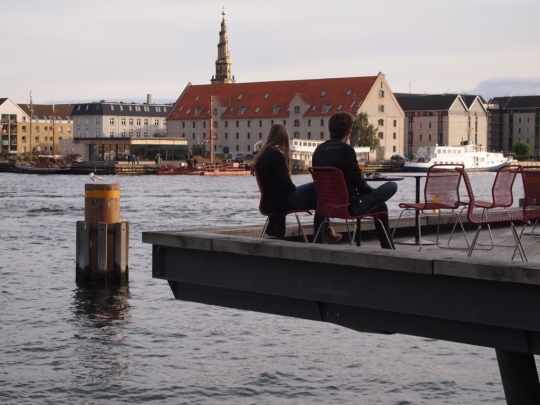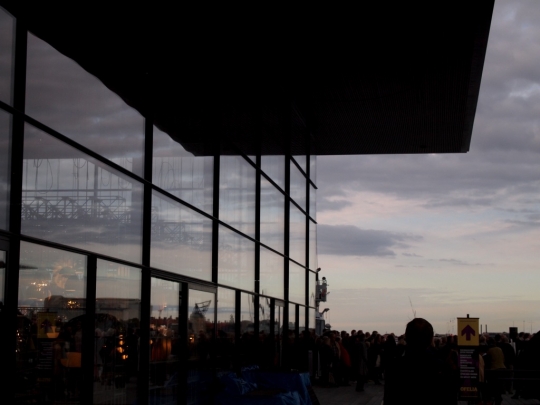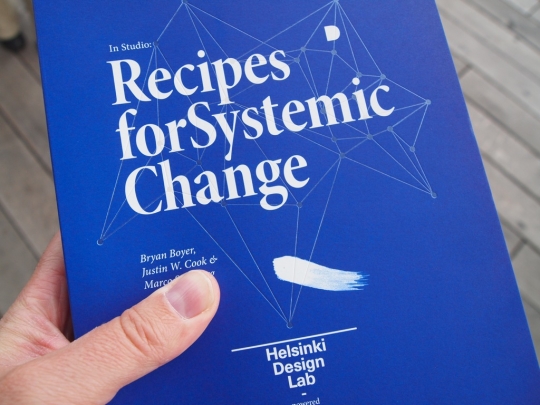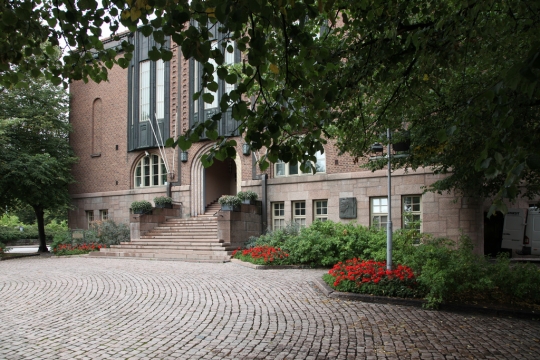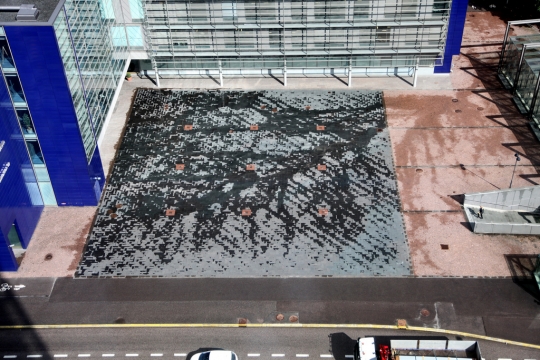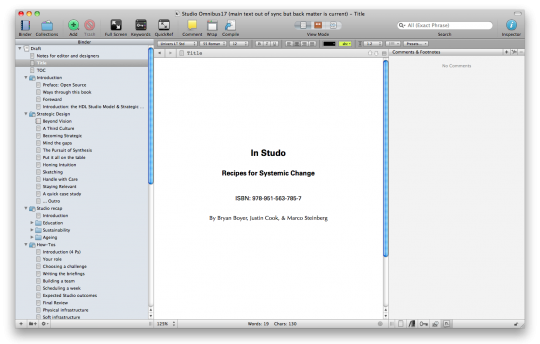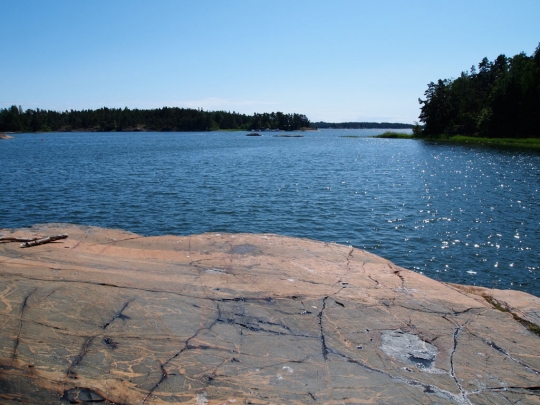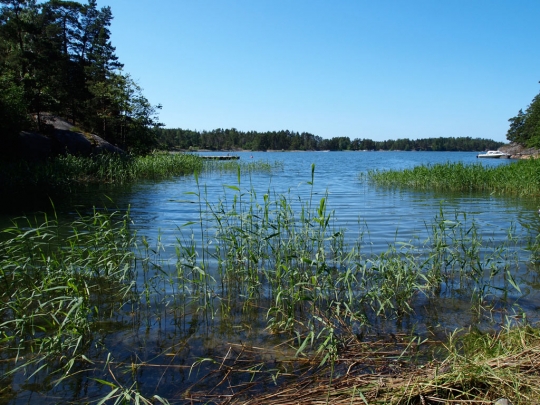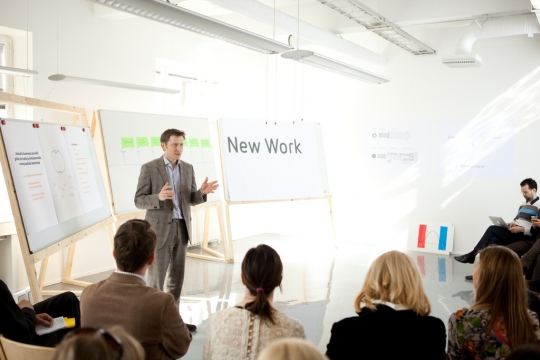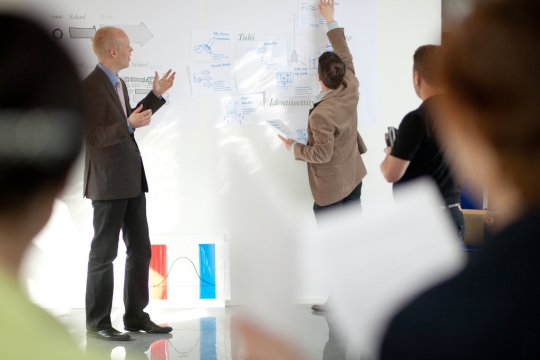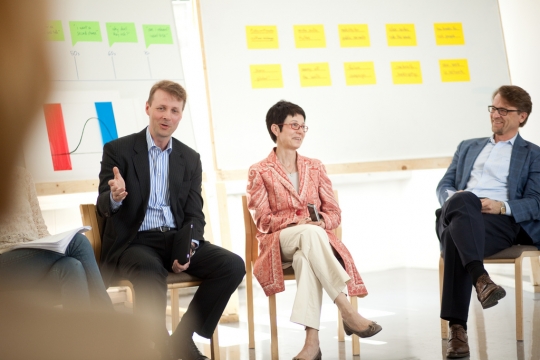Helsinki Design Lab helps government leaders see the "architecture of problems." We assist decision-makers to view challenges from a big-picture perspective, and provide guidance toward more complete solutions that consider all aspects of a problem. Our mission is to advance this way of working—we call it strategic design.
Catching up, catching up. As predicted, Autumn is here and the pace is picking up. Several of us are just back from Copenhagen Design Week, where we did a number of productive things, as well as just enjoying that fine city.
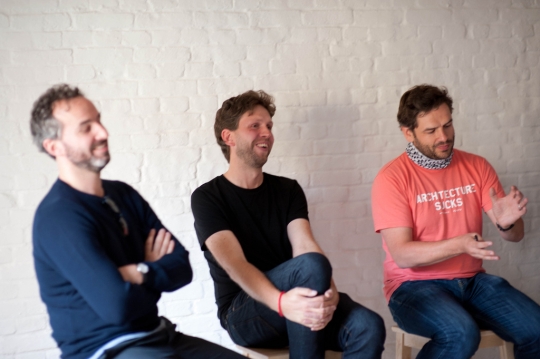
Me, Karsten Schmidt, and Matt Jones, photo courtesy of Matt Cottam.
I was there to speak at the Copenhagen Interaction Design Institute (CIID), with Matt Jones of BERG and Karsten Schmidt of PostSpectacular, organised by the great Matt Cottam (Tellart etc.) and Alie Rose (CIID). The talks from Matt and Karsten were both chock-full of challenging, brilliant thinking and as ever it was a privilege to share the bill with them.
I'll try to post some thoughts from my talk here (or there) later, but essentially it covered the shift from interaction design at the urban scale to strategic design at systemic scale, and the importance of designing both the matter (the objects, spaces, services) at the same time as the meta (the context, the organisation, the culture.)
Low2No is one of our primary examples. Here, what looks like a building project is actually a 'trojan horse' or 'hook' for a whole series of other systemic changes, around the forestry industry, smart cities, food culture, design methods, ownership models, carbon accounting, innovation environments and so on. So this was 'From Matter to Meta' and back again. There's a lot more to come here, but thanks to CIID for organizing and thanks to an attentive crowd, particularly taking the time out from a sunny Saturday afternoon.

Toldboden brunch, photo courtesy of Matt Cottam.
Bryan and I joined Team CIID + BERG for Sunday brunch at Toldboden, which we suspect may be currently the best brunch place in Europe, if not the world. We understand that this is quite a claim, but still.
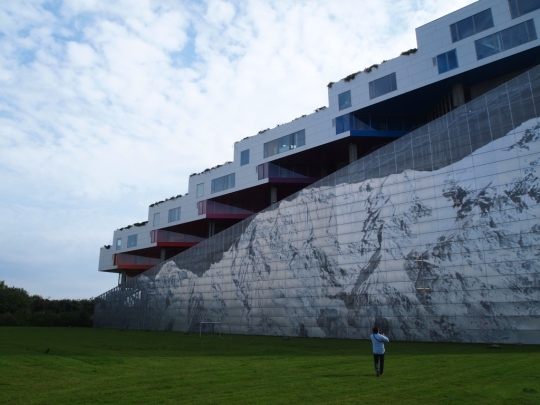
The Mountain, by Bjarke Ingels Group, Ørestad.

VM Buildings, by Bjarke Ingels Group, Ørestad.
Then just time for a quick excursion to Ørestad, to see a couple of fine, and by now well-known buildings by Bjarke Ingels Group (but also the fairly bereft streetscape there. Hmm.)
Bryan and Marco were in town to participate in a conference organised by our good friends MindLab. 'How Public Design? Leading Change in Government' was an international seminar featuring government, academics, design practitioners, and others. The foundations for the conversation were laid down by rich stories and case studies about existing design work within the public sector; the conversation itself often focused on how to scale this work up, and what new cultures of public sector might result, or otherwise be enabled. Thanks also to MindLab for a great event.
As well as general INDEX Award shenanigans (and congrats to one of our collaborators, Alejandro Aravena, for his firm Elemental's award there) we were also in Copenhagen to meet a consignment of The Book (around twelve copies sent to our hotel).
We finally have it in our hands. Called 'In Studio: Recipes for Systemic Change', the content unpacks the studio model and its use in terms of understanding the architecture of systemic challenges and quickly sketching out coherent, practical and imaginative visions that address such interlocking problems. Hopefully you'll find it a useful resource and a good read. Again, credit to Bryan, Justin and Marco for producing a genuinely original contribution, and particularly for Bryan for handling the production. The book looks and feels great, thanks to design by Two Points in Barcelona.There's a foreword by Geoff Mulgan of NESTA, and an afterword by our president, Mikko Kosonen. We'll post about the book separately, very shortly, including details on how to get it.
We've also been working on a dossier around design ethnography; please have a look and let us know what you think. Any comments gratefully received, particularly other references or case studies you think we should link to.
In other work, we've been working hard on Low2No, and I've been picking up two threads in particular: the 'smart systems' work (our informatics-led angles developed by Arup and Experientia) around the building, and then how our organisation develops in the context of the new building. The relationship between building projects and the organisations that inhabit them is complex and symbiotic, and as part of the client body for the block, and ultimately an occupant, we'll be using this opportunity to continue the development of Sitra the organisation too.
In terms of 'smart systems', we're trying to develop a more sophisticated understanding of what this might mean, particularly as compared to yer usual building project. On a typical project, ‘smart systems’ can essentially be seen as shorthand for 'automating everything in sight', which we feel would remove the opportunity for engagement, agency and responsibility from the various users of the building. Which doesn’t feel particularly smart to us.
So we're trying to build up a simpler but more engaged relationship between occupant and other users, building, building technology, organisation, and city. This should take advantage of contemporary thinking around smart systems and smart cities whilst preserving, even expanding, the role of people within and around the building. This is partly to do with our strategic objectives around 'sustainable well-being', and the desire to produce replicable strategies for systemic change, but also to do with creating a simpler, more effective, more enjoyable workplace.
These words might come back to haunt us—until a building is built and occupied, one never knows—but we want the exact opposite of the all-too-familiar hotel room experience in which you're searching for the impenetrable remote control required to turn on the standard lamp. Some things are not problems that need fixing.
Some are, however, and we think we're on to something new and useful with our approaches here. We'll report back on this too, as it develops, on the soon-to-be-relaunched Low2No website. (Yes, I'm aware this is turning into a series of nested links to future posts.)
In the aforementioned CIID talk, around matter and meta, one thing I touched on was redesigning the context around products, services, relationships. Or, as I put it here, "You can't design a transformative service without redesigning the organisation."
This follows the legendary Finnish architect Eliel Saarinen's quote: "Always design a thing by considering it in its next larger context - a chair in a room, a room in a house, a house in an environment, an environment in a city plan." i.e. the context is often an organisation, and so a complex net of relationships, one way or another. As I pointed out in my talk, I think you can go the other way too i.e. design the context considering the thing it is intended to produce. Again, it's symbiotic.
With this in mind, our work in terms of organisational change at Sitra is therefore part of this building project, part of this ICT procurement, and so on. Given that Low2No represents one component in another stage of development for our organisation—a Sitra v4.0 perhaps—we have also been exploring what a Sitra v3.1 or v3.2 might be (this numbering is just an example, as organisations are actually in multiple stages of development simultaneously; it also deliberately avoids using the dread word '2.0'!).
These are small-step experiments that we can do right now, iterations along the way to the new organisation in the new building. These are never binary or direct relationships i.e. the new building does not 'effect' the new organisation into life from day one, nor does a new organisation necessitate or articulate a new spatial context. It's never that simple.
So the .1, .2, .3 series of hops in effect enables the organisation to 'try on' new working methods, relationships, identities, new layouts, patterns and habits. It 'de-risks' the change implied to some extent—it makes a new building three years away into something more tangible and at-hand—whilst enabling the kind of instructive forward momentum that prototypes bring to other fields.
Not that Sitra needs redesigning, but Bryan and I did some work at our recent summer awayday in the beautiful forest around Mikkeli, helping our teams constructively imagine some new working habits, patterns and spaces. We may even be able to prototype some of these in our existing building in Ruoholahti, which helped this become more than just a paper exercise.
Oh, and I've also been writing up our research into food culture in Finland. More on that soon too!
Lots of little things, these last weeks. Perhaps this is appropriate since some of the trees around town are already starting to let go of their leaves. Increasingly, there are lots of little things all over the ground.
Justin and I have been doing a bit of work on a new website for Low2No, but it's mostly him down in the mine at the moment. I'm pitching in with advice here and there as we navigate that towards launch in early September.
Marco and Justin have been looking after the Low2No block itself, as they do in some form or another just about every single day. Justin was in Berlin meeting with our architects, Sauerbruch & Hutton, on the design of Sitra's new offices. Meanwhile Dan and I have been working in-house on the continued development at the intersection of Sitra's offices and the cultural aspects that this change will open up. In the process we've been making lots of lists, often involving spectrums or continuums, that try to articulate the qualities we're looking for in the new offices. Boxes, be gone.
We shared a brief but good discussion with the Elinvoima team trying to help them narrow in on a fertile topic for the next round of the forum. It was a discussion that spanned from the invention of democracy to the national anthem of the Czech Republic and the rhino-shaped capital of South Sudan. Marco was with them again for a longer planning session.
True fact: the team was in Lahti for half a day and the train ride back (and subsequent lunch) were some of the most productive hours of the entire week. During which time we revisited the conversations Dan mentioned last time and got one step closer to An Answer. I suspect it surprised all of us how quickly a disjointed set of possibilites seemed to lock into place just at the end of lunch. Undoubtedly this will have jostled itself loose again by next week, but as long as things come together for a moment of clarity on a regular basis we're on the right track.
Otherwise: more book related odds and ends, a visit from Sanna and her three month old baby boy, sorting out our need for interns (get those portfolios ready), a braindump from the legal team, and some hurried videography shooting ghostly clouds dropping rain. Lots of little things.
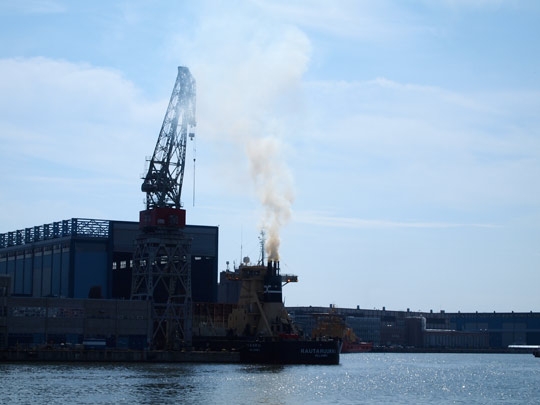
The docks don't stop working.
And ... we're back.
Finland returns from its summer break en-masse this week. Cafes, trams and shops are suddenly full again, although the collective mood still seems to be sunny, light-headed, and a little, er, un-focused perhaps.
However, the aforementioned Book finally made it over the line, not least thanks to Herculean efforts by Boyer, who apparently barely got the aforementioned summer break. We have a dummy copy in the office, but the real thing is emerging from printers as we speak. Given it was largely produced before I got here - I merely helped with the edit a bit - I can say it's looking great. More details soon.
The team spent much of the break with the next iteration of Helsinki Design Lab ticking over in the back of our minds, our emerging ideas no doubt inflected by several of us being in the US, UK and China at various times, as well as Finland. Occasionally, a couple of us were in the same place at the same time, and took the opportunity to scribble and think.
And we're getting there. We know it's going to be a progression of last year's studio work (which will be the subject of The Book, by the way).
If the studios were about trying to shape the right questions - or to understand 'the architecture of the problem' - then perhaps we now want to look at the way we shape processes to get things done; to connect vision and opportunity to reality.
A key word from our mission here would be stewardship, but we're also finding ourselves discussing prototyping and procurement, courage and risk. We have an all-day session next week during which we'll unpack this a little more.
Something else that couldn't help but "inflect our thinking" has been the unfolding dramas in the debt crises across Europe and the US: It continues to be uncomfortable if compelling viewing, from one which can only conclude that our current approaches are not coping with the 21st century particularly well so far. It's interesting how this is often an expression of something as intangible, qualitatitive and complex as confidence or trust - or rather lack of it - and so today's overly reductive analytical tools and processes also seem ill-equipped to address it.
And finally, with respect to governance and deliberation, two things caught our attention this week.
Firstly, the Mayor of Vilnius takes the matter of illegal parking into his own hands, deciding that "a tank is the best solution".
Secondly, Switzerland, we salute you!
We're still technically on holiday here until next week, but things are coming along with our book project so I thought I would share some pics from the process of bringing something to press.
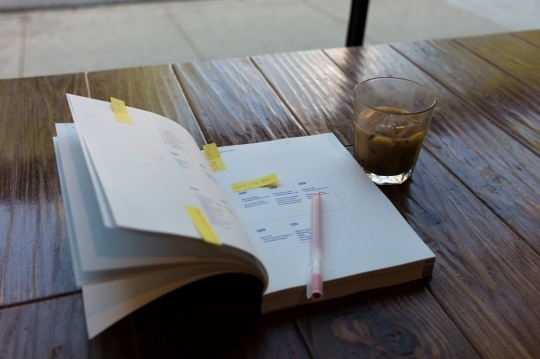
An early dummy. We used this to mark up all errors and changes.
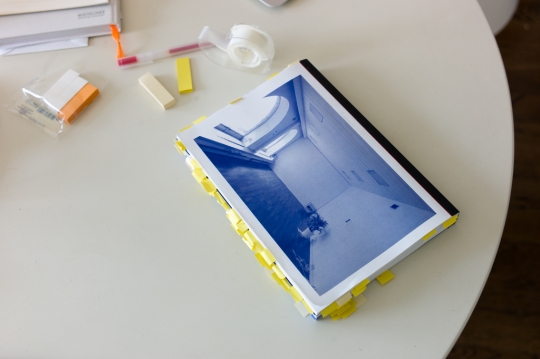
This is just after marking all of the changes and updates. There were a lot of things to fix.
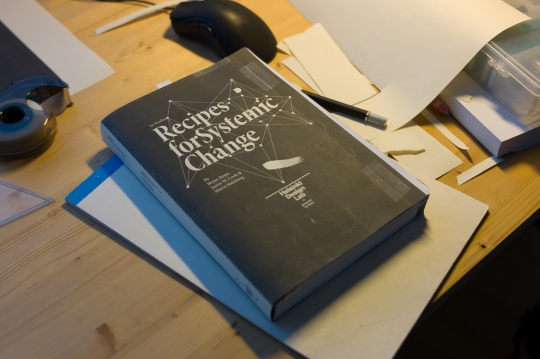
Mocking up the cover on a dummy book.

Plotters from the press. Testing ink distribution and other technical elements. Spotted a couple more issues to be resolved too.
Back next week with a real weeknote!
It's July so most of us are on vacation (along with the rest of Finland). Unfortunately publishing deadlines do not go on holiday, so we are still clocking in to work on the book. Getting there.
Well, that's something.
We did start the week with that conference call Dan mentioned, and it was good, but otherwise pretty quite around these parts. Justin and Dan are on holiday. I'm on partial holiday. And Marco has been out of the office at the Tällberg Forum.
Recommendation: Enjoy summer. Weeknotes will be thin now till August.
In brief: Summer continues to unfold in all its richness. (This is actually code for highly variable weather and a flurry of increasingly urgent meetings, but still.) Marco, Justin and I continue to work on Low2No, including several meetings with Sauerbruch Hutton, Arup and Experientia, as well as the local client body. I talked to Monocle about some of the related challenges facing Helsinki in terms of these and other redevelopments. Bryan heads off to the US for a series of catch-up meetings and book edits, initially in New York before joining forces with Justin in Boston. And while the cats are away, Marco and I have a good first planning session on what a 'Helsinki Design Lab 2012' might be.
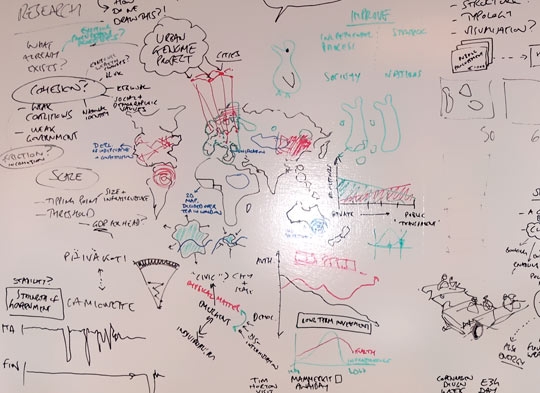
Further: After a few hours of Marco and I whiteboard hacking on Thursday morning, the place is a mess of intriguing scribbles—graphs, maps, arrows, and various molecular diagrams.
While it's too early to describe an emerging agenda for the next iteration of HDL—Marco likened the process to taking the old machinery out of the barn—there are some firm ideas coalescing, particularly around how what governments and governance mean in a world of weak coalitions and apparently dissolving certainties. That's what the scribbles allude to, and both Marco and I are quietly excited by the potential in the directions appearing on the board.
Next week we'll start to unpack these starting points as a team, such that we can begin to develop both a line of enquiry and a plan of attack. We have a loose-fit timeline emerging, which feels good, sketching out a busy year ahead.
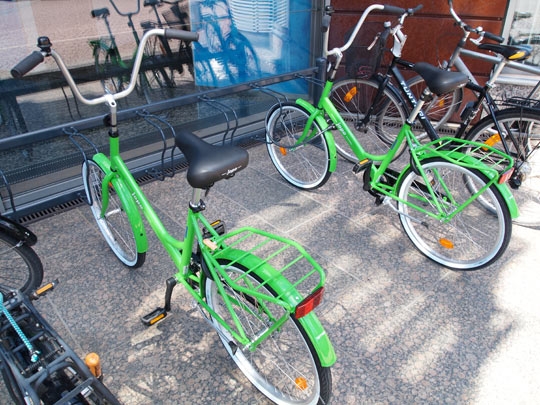
Elsewhere: Sitra now has a couple of Jopo bikes for staff use to get to/from meetings. Jopo are a great Finnish design-and-build story, originally from the mid-1960s, and certainly ready for a little more international attention. The name 'Jopo' comes from JOkaisen POlkupyörä, meaning 'everyone's bicycle'. Originally exemplifying the flatness of Finnish society—a kind of "collective individualism", in their words—the design was resurrected in the 2000s, building upon its easy, vibrant, 'everyday industrial design', based around standard, modular frameworks that are fast to modify and personalise. So, a design-to-manufactured system emphasising the collective that is capable to bending to the individual. A lot of metaphors to play with here. In the meantime, a good healthy way to get to meetings.
One such meeting this week was with Jenna Sutela from OK/Do, a local design-think-tank of some repute. Bryan's previously written about the excellent Clues to Open Helsinki cards produced by OK/Do, Sitra and others last year—a gently inspirational project for many of us working in urban strategy. And before my formal involvement with Sitra, I also attended a great discussion they organised last year as part of their OK Talk series, which featured Bryan, Hanna Harris (The Finnish Institute in London), Amanda Levete (AL_A), Shohei Shigematsu (OMA NY) and Nene Tsuboi (NOW for Architecture and Urbanism). At SIS Deli, Jenna and I talked about the work they'd done with the Oivallus project on the future of education and work in a networked economy as well as their lovely new book OK Talk Helsinki-London, of which more later.
We also discussed how small creative firms here seem to have trouble locating good premises, despite there being space available. We thought there might be room for a stackd-like system at an urban scale, that understood—in a Renew Newcastle sense—how the more fluid firms might be able to occupy space, and matched spaces with uses accordingly. We'd certainly be interested in hearing about any examples of such systems.
And though the Anglo-Saxon in me is horribly aware of all the talk of holidays in recent weeknotes, but this particular week happened to coincide with Juhannus, the Midsummer holiday, and so another mention is unavoidable. Given its intensely seasonal nature, and the relatively brief duration of summer, the importance of Juhannus to Finland can hardly be overestimated, and after a brief storm on Thursday night some of us were treated to a long weekend of bright warm sun and long, light nights, perfect for puttering around islands in small motorboats, sauna and swimming in the gentle if frightfully cold Baltic, and big communal dinners of smoked fish and new potatoes.

As a result, all thoughts of systemic change kept returning to local food systems, producing sustainable versions of communal firewood-burning saunas en masse, and creating low-carbon mobility systems between the Nordic region's cities and their distributed footprint of summer houses. Governance will have to wait.
With Juhannus now days away, we're transitioning from a spring of spiky activity that came in high and rapid peaks to a mid-year that is more even-keeled. As Dan mentioned last time, this includes experiments in our collective workflow, such as new rituals involving the whiteboard.
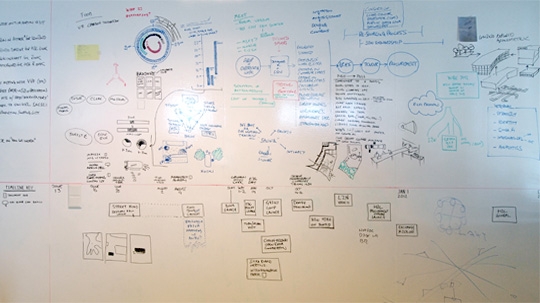
One week's worth of thoughts, notes, conversations, ideas, and misfires.
A couple balls rolling at the moment, all in different directions and each with their own pace. Marco, Justin, and Dan are each deep in their own corners of Low2No and I've been pitching in a bit here and there; our peek into the culture of street food in Finland continues; and we've been reflecting on and documenting our experiences as a cross-functional unit within Sitra. This last bit is part of a larger transition that is happening within our organization. So in addition to a lot of time spent at the board, we're also regularly whipping up one-pagers and trying to distill our experiences into easily digestible documents. As frustrating as it may be to constrain oneself to a single page, the discipline of brevity is a good and worthy challenge.
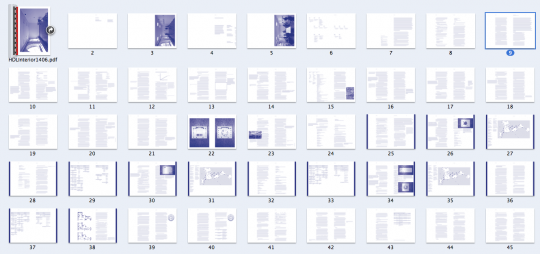
Draft book spreads. These are only a few days old and yet already things look much different.
And then there's the book. Now that we've organized and hosted a total of seven studies, our knowledge about how to do this sort of work is stabilizing. With interest about the Studio Model from Belgium to Brazil we decided that a 'recipe book' would be a good format to share some of our experiences (and hopefully insights)—so that's exactly that we're doing. After spending winter and spring writing, we're now in production. Editing, layouts, images, diagrams, and more. Martin at TwoPoints has been peppering us with questions about bindings and other arcana of bookmaking, which usually send us off into a small spiral of consideration before we come back with a decent answer. As these aspects calm down we are starting to think about electronic publishing. There is, quite frankly, a lot to do. So far it has been a relatively painless process. So far.
If you missed it, earlier this week we posted a slew of photos from the studios that we organized last month. Ivo shot in color this time so they look different. Last year was gritty chiaroscuro, but this year the images have an otherworldly lightness.
Over in Denmark, our friends at INDEX send word that they've posted the finalists for the 2011 INDEX: Prize. Congratulations to all of them—and good luck on the final round of competition.
And now that we have a healthy history of weeknotes we can do neat things like this: This was week 117, one year ago we were in Week 065. Moi Moi!
As we mentioned previously, last month we were working with the Synergize Finland team to run three concurrent studios on the theme of "new work". The details are continually pouring onto the Synergize (Elinvoima) website, so you can hop over there for the updates as the programme continues, but here's a peek at the week in an abreviated form.
Monday
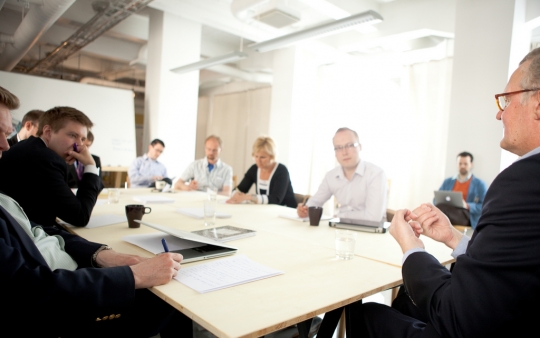
Esko Kilpi talks with the 'new knowledge work' studio team about the ways that social media and the internet are changing working relationships. Monday was full of talks with guest speakers.
Tuesday
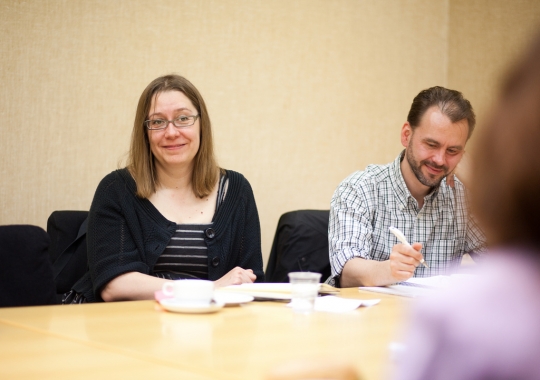
Tuesday each of the three studios were out and about all over Helsinki, making site visits to see the realities of contemporary work in each of the three themes. This is a scene from the group who visited the City of Helsinki offices to talk about immigration and work.
Wednesday

With a bit of top-down and bottom-up perspective percolating from the first two days, Wednesday is when things really got down to business. The teams were in studio all day beginning to synthesize their insights and ideas through group discussion...
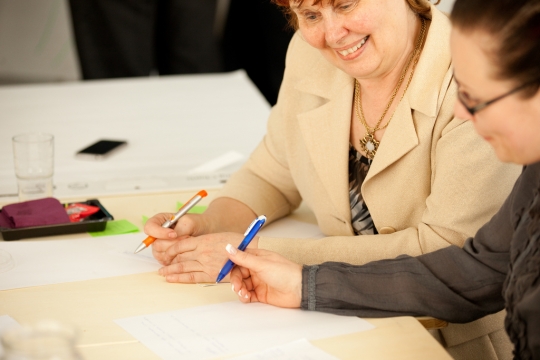
... and collaboration in pairs.
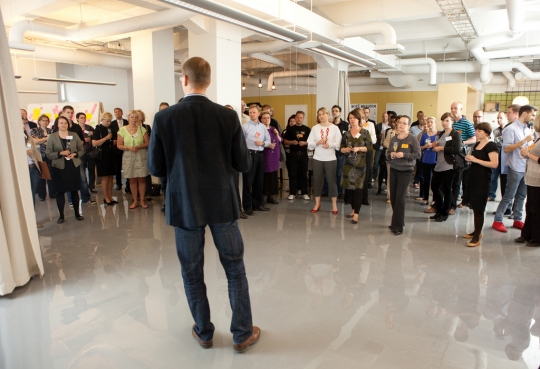
That evening we had a town hall meeting with 60 guests where each of the three studios gave a 4 minute 'elevator pitch' of their current thinking.
Thursday

Marco and the rest of our Strategic Design Unit were continually 'sparring' with the studios to help them hone their proposals.

As the end of thursday came near, the deadline began to loom large. We ended each day with a dry run—'what if you had to present now?'
Friday
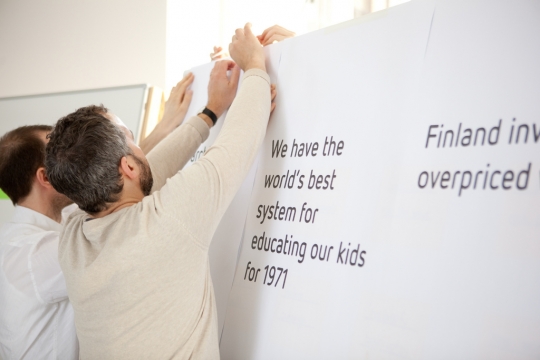
Dan and I stayed late on thursday night to help the teams wrap up their presentations. No one used Powerpoint, so there was a lot of paper-wrangling come friday morning.

The three teams presented one after another, each giving their version of the big picture and sharing a collection of 10 action areas each described in sketch form, both verbally and visually.

Amongst the audience were five special guests to give focused feedback: Annika Forsander, Kirsi Juva, Mikko Kosonen, Risto Siilasmaa, and Anni Sinnemäki.

Anni Sinnemäki responding to a question by Mikko Kosonen.

After the presentations concluded we moved all of the chairs out of the way and set up a big table to continue the discussion during a casual lunch.
Next Steps
After the studio week the teams have had a subsequent session to begin developing some of the action areas into social innovation projects. The trajectory of that work is based on the rapid development of a big picture 'architecture of solutions' in studio and will culminate this fall when Sitra hosts everyone again for a celebration and announcement of the projects that are continuing forward.
As for us, we learned a lot from the week and it was an especially useful experience to run multiple studios concurrently. Exhausting, to be sure, but useful.
By nature of being an internal collaboration within Sitra we also dedicated time to articulating in a more careful way how to put something like an HDL studio together. Part of this was iterating and formalizing the tools and techniques that make each of the days tick.
One example is an 'ethnography field guide' that we developed with the help of WeVolve for the fieldwork on tuesday. On my plate is to finish up the English translation and get that document up here as a download, which will happen before summer kicks in.
In the meantime, there are many more photos of the week on our Flickr account. Enjoy!
All photos by Ivo Corda.

Summer on Seurasaari
Helsinki is now basking in full summer, with a couple of days touching 30 degrees this week. The city is glorious like this, with every inch of street, park and pavement full of life, and islands like Seurasaari become impossibly appealing places to spend a Sunday afternoon. Like opposing points of a compass, Helsinki can be differently beautiful in hot sun/midsummer and deep snow/midwinter—it's the bits in between we have to work on.
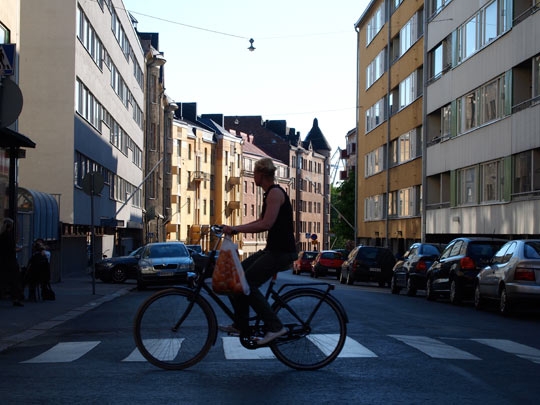
Or work in, perhaps. We are all horribly aware of the month-long summer holiday slowly approaching, in much the same way that Christmas creeps up on British workers. Both are looked forward to, of course, but both compress time either on either side, leading to an increasingly frenetic rush of meetings and proposals.
This week is no exception. Personally, my work on Low2No is beginning to pick up pace, meaning meetings with various people inside and outside Sitra—including a chance to catch up with our partner Irene Cassarino from Experientia, and researcher Tiona Zozul from Harvard Business School—as well as making the most of Justin being in town. Both Justin and Marco were heavily focused on Low2No this week, though also helped guide our other various project ideas into our other various programmes, before Marco disappeared for a well-earned week of R&R in southern Italy and Justin took off to hold the fort back in Boston.
Bryan knocked off some significant milestones in completing the first in what will hopefully be a series of HDL books, exploring the process and potential of strategic design in this context. More to follow on all this, when the time is right.
A couple of weeks ago, I wrote an article about Helsinki for my old employer Monocle magazine (see forthcoming July/August edition on liveable cities) and in doing so I spoke with both Mayor Jussi Pajunen, and the City's project manager for their 'food culture strategy', Ville Relander. Both emphasised how the City's burgeoning food scene has become a weathervane of the changing Helsinki, and perhaps Finland, which has also played to our own interests in food as an area of potential systemic change with regards to sustainable well-being—at least when food is viewed as a deeply cultural and complex field of interdependent networks and supply chains, which affects everyone and all places, one way or another.
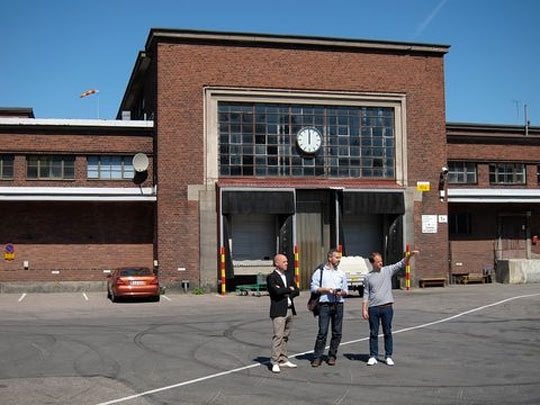
Justin and Dan meet Ville Relander.
So on Wednesday, Bryan, Justin and I went to visit Ville up at his temporary HQ, the city's old wholesale markets amidst the urban regeneration of the Kalasatama area. The markets are a core part of the city's food culture strategy, with the idea that they become a social space as well as a place to source ingredients, perhaps akin to London's Borough Market, Melbourne's Queen Victoria Market or Barcelona's Mercat Santa Catarina, but refracted through the prism of Nordic cuisine and public space.
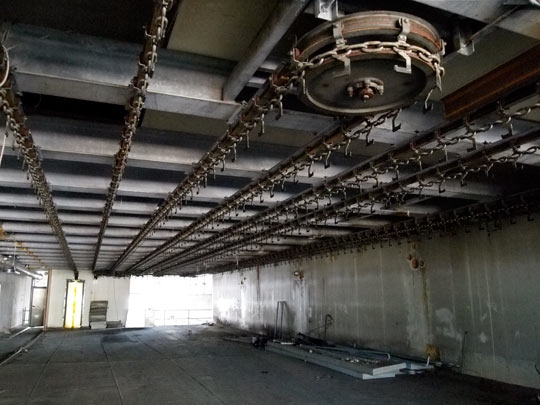
Sikasirkus, or 'pig circus'
The main slaughterhouse building is an incredible asset, with a sturdy yet elegant, long low form that is perfect for re-appropriation, and some horrifying/appealing features such as the sikasirkus (yes, that translates to 'pig circus') for transporting pig carcasses through the building. The place still smells fairly porky, but has huge potential.
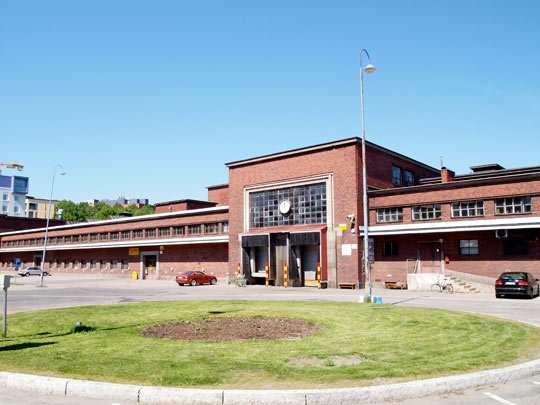
Wholesale market at Kalasatama.
Ville is clearly an asset too, of a very different kind, and he spoke with enthusiasm and insight about the City's approach to food. The City of Helsinki has significant impact on the food business, not least due to the fact that tens of thousands of hot meals are served every day in the City's kindergartens (päiväkoti in Finnish)—where most kids go to pre-school—and so its aspiration to make half of this kindergarten food organic by 2015 could impact positively on supply chains across the region.
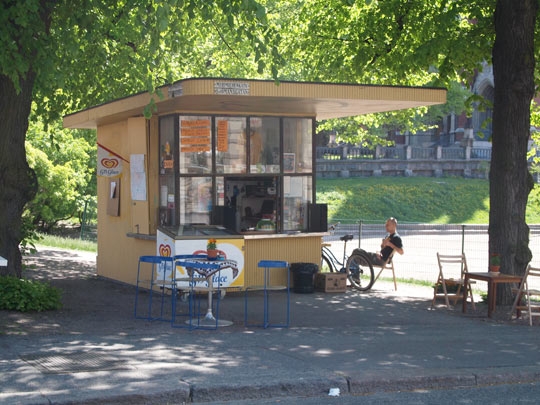
But the City can equally impact the street and its food too. As noted previously, we're researching this area very closely—currently, The Saga of the Camionette, and What It Means for Helsinki. Watch that space.
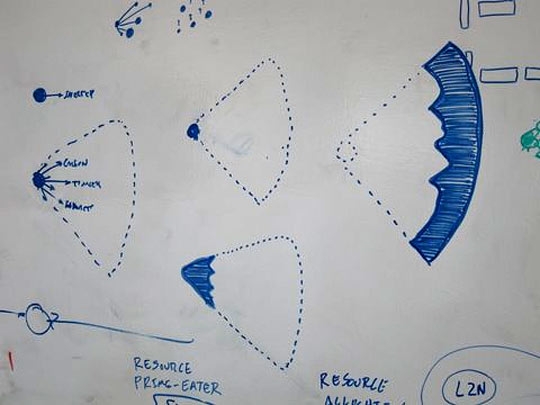
Sketching systems.
This also means we're diagramming furiously of course, both for the aforementioned book and also generally, trying to find ways of suggesting a strategic design approach that connects 'the päiväkoti and the camionette'.
Which leads me to a brief note on whiteboards (to follow up our previous on Post-its). Given our rhetoric around 'designing the conditions' around systems, it's only right that we look at our own working environment from time to time. And this last week's iCloud announcement from Apple, combined with our ongoing fascination with services like Square, had Bryan and I trading ideas back and forth, not just about new public and private services made possible by such advances, but also our own workspace.
Accordingly, we've been developing our internal 'knowledge management' systems (hacking together Tumblr, Dropbox, Basecamp, Twitter, Facebook and various other more bespoke systems), the hardware we use (including gearing up for more video, perhaps saving you reading all these words every week), and conjuring up entirely new approaches to sketching and scheduling on our floor-to-ceiling whiteboards.
It's interesting how bespoke this all is—how workflows, tools and culture are hardwired into the particularities of teams and places—and that despite attempts to systemise this, bespoke feels right.
Anyway, if the whiteboard system works for more than a few weeks, we promise a full exposé at a later date. If it doesn't, forget I ever mentioned it.
As June begins we've been working on a number of small bits: helping some of them grow into slightly less-small bits, and eventually real projects. In other words, sketching, discussing, calendaring, prioritizing.
On Thursday we had the luxury of spending an entire day to look at only two issues. That much time dedicated to such a limited agenda is nice and by the end of the day we were all exhausted.
What else? Some quick hits:
Dan was at Aalto University to give a presentation in the Pragmatic Utopias seminar
We at Sitra launched a new website in beta form. This has been a long time coming and we're excited to have it as a more fluid way to share our work. You can read about strategic design in English and in Finnish (and more content will be available in English in the fall).
HDL can now be found on Tumblr, where we are blogging things that look interesting and related to strategic design. If this experiment works out we will figure out a way to bring some of that content onto this site as well, but for now it's in a separate sandbox at helsinkidesignlab.tumblr.com.
So let's face it, if you're reading this site and you just thought about clicking that link for the Tumblr blog, then perhaps it's time that we make our friendship official. Luckily, Facebook is here to help us Become Friends. In other words: HDL can now also be found on Facebook, where you can can give us a thumbs up if you're inclined. Or generally follow along with what we're doing.
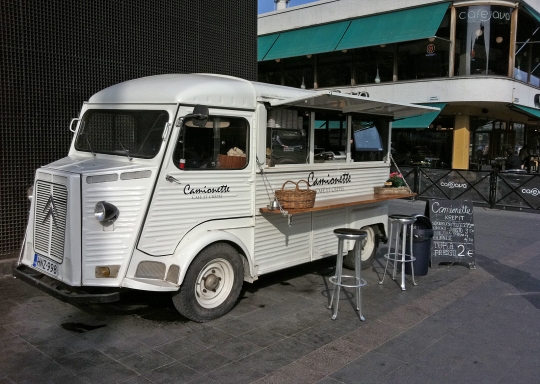
Being open 24/7 gives the operators of Camionette a valuable perspective on the affect of their offering on the street culture around their truck. Hint: It's much different at night.
And finally, the Strategic Design Unit has been talking a lot about street culture, and in particular the way that food helps set the tone of the street. This was aided by a visit to Camionette, Helsinki's first food truck. Tasty.
